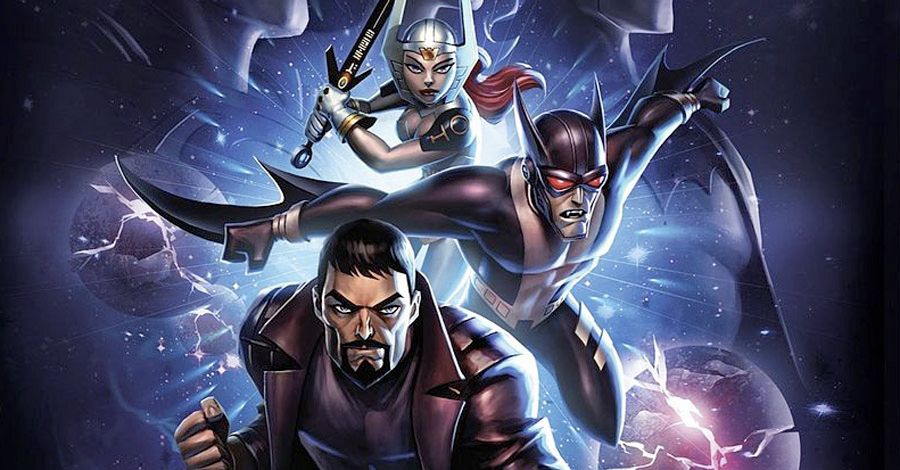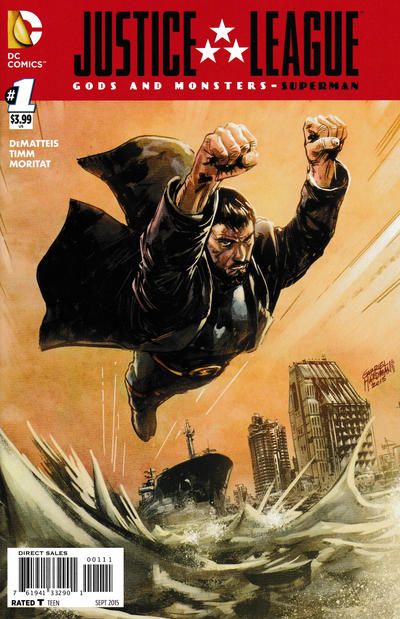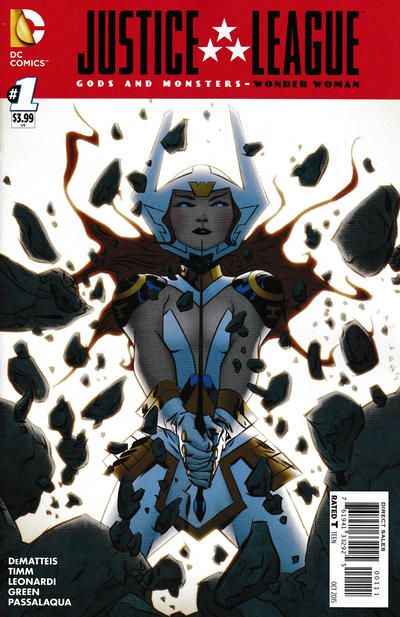DC Entertainment's latest direct-to-DVD animated film, Justice League: Gods and Monsters, marks the return of Bruce Timm to DC's superheroes. Timm is, of course, a familiar presence to a generation of fans, as cartoons featuring his design style and creative input were on television from the 1992 debut of Batman: The Animated Series to the 2006 finale of Justice League Unlimited (and those shows and everything in between them now live forever online and on DVD).
Gods and Monsters features Timm's designs, and he additionally co-wrote the story with longtime collaborator Alan Burnett and executive produced the film (Sam Liu directed it).
DC is certainly treating the film as an event, as the company has produced a suite of a half-dozen tie-in comics, something not usually done for animated projects (although it should be noted the bulk of its recent animated films have been direct adaptations of particular story arcs, making comic tie-ins redundant; Gods and Monsters shares a title with a 2001 JLA one-shot, but is otherwise an original project).
The film shares the same basic problem as almost all of its ilk: It has the super-short run time of a project meant for kids, but is rated PG-13, and the producers have used all the gore and swearing the rating allows. So, as with its many direct-to-DVD predecessors, Gods and Monsters feels like a kids movie that's inappropriate for actual kids, or perhaps a particularly juvenile animated film for adults, one lacking the space or room to do much of anything once the requisite plot and action is accounted for (the fact that this film is done Timm-style does make the occasional gore and swearing a little weirder, admittedly).
It's an Elseworlds-style film in which Earth's only real super-people are Superman, Batman and Wonder Woman, but there are very different people using those names. And although they serve as superheroes, as individuals and as a team they hover between being good and evil. As with most of Timm's works, the character designs are excellent (I particularly like the Golden Age-inspired Batman costume), and the voice acting is top-notch, with Michael C. Hall's performance as a dead-inside Batman the most outstanding.
But as strong as particular elements might be, it's a particularly pointless film that flirts with some interesting ideas but never actually pursues them. It's certainly worth a fan's time, but doesn't stand on its own.
To spoil its surprises, it imagines a world where the baby that escapes the destruction of Krypton and lands on Earth to grow up to be Superman isn't the son of Jor-El, but rather the son of General Zod.
Additionally, he's adopted not by the Kents, but by Mexican immigrants. That last bit is a rather inspired update of the Superman story, as in the beginning of the 20th century one of the more resonant images of the immigrant would have been someone from Europe arriving in a New York City-like big city and trying to "pass"; in 21st-century America, immigration is an entirely different story and set of images. That's an update that seems more appropriate for Superman: Earth One, and not an Elseworlds where Superman grows up to be a fascist jerk on the cusp of conquering the world.
What went wrong with this Superman? Was it a simple matter of genetics, or was it the environment in which he was raised?
The idea seems to be that without the real Superman to serve as an example, almost no other superheroes rise up to follow him, and those that do are twisted versions. Batman isn't Bruce Wayne, but Kirk Langstrom, who accidentally turned himself into a Morbius-like vampire while trying to cure his cancer. And Wonder Woman isn't Princess Diana of Themyscira, but Bekka of New Genesis. All three are more than happy to use lethal force on their frail human foes.
About a dozen or so super-scientists play roles in the film, but they are just scientists: Ray Palmer and Ryan Choi aren't The Atom, John Henry Irons isn't Steel, Will Magnus doesn't really create his Metal Men in quite the same way, and so on. These characters, most of whom get little more than cameos, appear because someone is apparently killing off super-scientists who were involved in a particular government project, and the trail seems to lead back to the Justice League.
Likely suspects include President Amanda Waller, Army Guy Steve Trevor and Lex Luthor, who here seems to be suffering from ALS.
The idea that if you take Kal-El out of the equation, the DC Universe becomes dark and broken doesn't quite work here because the film doesn't really follow a straight and logical path from that point, like, say, Alan Davis and Mark Farmer's JLA: The Nail, or even the more popular and influential Kingdom Come, which examined a future if Superman left at a particular point in history.
Surely Bruce Wayne would still watch his parents be murdered, and Steve Trevor's plane would still crash on an mythical island of warrior women. Similarly, it doesn't account for the random rejiggering of circumstances, like Kirk Langstrom and Will Magnus being college friends, or weird shifts in alignment, like the New Gods being brutal killers who slaughter the evil gods of Apokolips during what was meant to be a peaceful wedding between Bekka and Orion (that scene is the most comical, given how thoroughly Jack Kirby telegraphed how pure good and pure evil the two factions were).
And so once more a potentially good 90- or 120-minute film has to be trimmed, cut and smooshed into a too-short run time, leaving room for little else other than some pretty cool animated action scenes.
Of course, the presence of the tie-ins should help alleviate, if not rectify that, no? After all, it will give more space to the characters and world of Gods and Monsters, and perhaps the creators of the comics – Timm co-plots them with J. M. DeMatteis, who handles the scripting – can explain the questions the film raises.
The six tie-in books consist of three one-shots (each starring one of the Leaguers), and a three-issue Justice League series. The one-shots have already come out, while the mini hasn't. It's therefore too early to say whether the miniseries meets that goal, but the one-shots, sadly, do not.
None of them is drawn by Timm, whose comics work is even more infrequent (and worthy of celebration) than his animated projects. Nor are they drawn by artists with styles similar to Timm, or artists willing or able to ape his style. Darwyn Cooke does provide covers ... but only variants. The artists chosen instead do fine jobs on their particular stories, but they don't look right for the setting, particularly Matthew Dow Smith, whose art on the Batman special is the polar opposite of the stripped-down and abstracted cartoon style of Timm.
Additionally, the three one-shots all take place between the parts of the film that show the characters' origins in flashback and the present day, so DeMatteis and Timm provide more information on their backgrounds, but the film itself takes care of the Point A and Point B of their stories; these then are like, I don't know, Point A.5 or something.
Justice League: Gods and Monsters–Superman #1 (whew, that's a mouthful!) features art by Moritat, and expands on the story of young Hernan, who works the fields alongside his adopted family, which includes a devout Catholic mother, a father who believes in the American dream and a sister the film didn't even mention.
In the book's 30 pages, we seen Hernan grow from a scared little boy always trying to hide his super-powers to the goateed, black coat-rocking Superman who executes a Mexican drug lord in his bed with heat vision. If nothing else, DeMatteis' script makes clear that being adopted by migrant workers from Mexico rather than by farmers from Kansas wasn't the reason Superman went bad ... at least, not directly. His parents are saintly and set good examples for him, but the way the rest of the world treats him, his family and his people certainly puts a chip on his shoulder. It's in Mexico that he sees the depths of human depravity and embraces his powers and the willingness to use them to kill evil people.
Did I say nothing else? I shouldn't have said that. This book also provides 30 pages of excellent artwork, and that's always welcome. I hope DC can find another and more worthy home for Moritat's work soon.
That was followed by Justice Lague: Gods and Monsters–Batman #1, perhaps the worst of the three. Batman's origin is so key to the film's storyline that Timm and DeMatteis mostly have to avoid even referencing it here, and, unfortunately, we don't get to see him in his cool Batman suit after the glimpse on the cover. Instead, he spends the entire comic wearing a black ski mask; coupled with the realistic art, this looked more like an issue of Archie's The Black Hood revival than a tie-in to a cartoon starring a vampire Batman.
Somewhat incongruously, after becoming a pseudo-vampire, Langstrom abandons his super-scientist friend Will Magnus and becomes a semi-homeless guy with a DIY lab in which he tries to cure cancer and vampirism. When he comes up with the bright idea to only kill bad guys for their blood, he slays a Gotham gang boss and ends up befriending the mobster's son.
This comic potentially answers the question of whatever happened to Bruce Wayne: Langstrom kills Joe Chill, so perhaps Chill never went on to murder the Waynes, leaving Bruce to happily miss out on becoming this universe's Batman. It also introduces a Francine, which may explain Langstrom's life-long crush on Magnus' girlfriend, rather than his ever meeting and marrying his wife from the "real" DC Universe.
The final one-shot was this week's Justice League: Gods and Monsters–Wonder Woman #1, which is definitely the oddest of the three. It skips her life among the New Gods, opening with a Boom Tube depositing her on Earth in 1962. After being nursed back to health by a kindly Hindu couple in India, she wanders the world for a while, and eventually falls in with some hippies, moving to a commune lead by Guitar Joe and Doctor Psycho.
This one is drawn by Rick Leonardi, and is pretty inspired in its convergence of Jack Kirby's appropriation of hippie culture into his Fourth World mythology with a character hailing from the world at the center of that mythology. Bekka creates her own commune, New New Genesis, and teaches those that live with her how to expand their minds not through drugs, but through her Mother Box.
That helps make it an interesting endeavor, although its also rather necessarily removed from the events of the film. Ending before the 1960s do, Bekka still has a good 45 years before the film catches up with her.
The Justice League: Gods and Monsters series, which will ship weekly starting on Wednesday, is more promising, as it will put all three of the heroes together for a shared, in-costume adventure, and serve as a more direct prequel to the film, starring the same Justice League. If you still feel like celebrating, of course.
Me, I think I'm ready to move on to the next film ... and/or some Bruce Timm-drawn comics.



